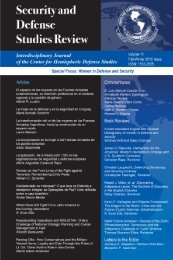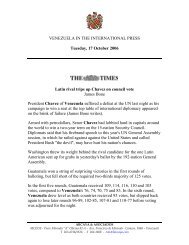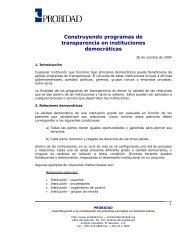provided other regions in the world. Indeed, in terms of percentage, our total foreign direct investmentin the Hemisphere equals our direct investment in Asia, the Middle East, <strong>and</strong> Africa combined!Additionally, we should not forget that the nature of U.S. bilateral trade in the Hemisphere isfundamentally different than that of China’s. While the U.S. is a strong net importer from LatinAmerica, China is a net exporter. While the U.S. imported $385 billion from the region in 2008 <strong>and</strong>ran a roughly $100 billion trade deficit, China imported $71 billion from the Hemisphere (more thanfive times less than the U.S.). The relative benefits of U.S. trade in the region are clear. Finally, thenature of our economic engagement in the Americas encompasses more than trade <strong>and</strong> investment.As neighbors who share large populations of common heritage, our economic relationship includesfamilial ties. The clearest example of this, of course, is the flow of remittances from the U.S. to LatinAmerica <strong>and</strong> the Caribbean. The Inter-American Development Bank (IADB) estimates that $42.3billion in remittances will flow from the U.S. to the region in 2009, slightly more than two-thirds ofthe IADB’s estimated world-wide total of remittances to the Americas.I highlight these figures not because I fancy myself an economist or enjoy lulling my audienceto sleep by rattling off statistics, but rather because it puts into perspective the relative depth, scope,<strong>and</strong> long history of U.S. engagement in the Hemisphere. I believe it is important to keep this historyin mind in order to better frame discussions on countries whose engagement is relatively new to theregion. Of course, my comments on history <strong>and</strong> context should not be misconstrued. The rapidity atwhich Chinese, Latin American, <strong>and</strong> Caribbean trade is growing is noteworthy because it increasesthe likelihood that China could become an enduring part of the economic l<strong>and</strong>scape of the Americas.In the long-term, China’s investments <strong>and</strong> interests are likely to exp<strong>and</strong> <strong>and</strong> evolve in ways both easy<strong>and</strong> difficult to predict, which is precisely why we have gathered here today.In returning to the notion of Chinese cooperation within a larger hemispheric framework, it isuseful to highlight what the U.S. Department of <strong>Defense</strong> considers to be some of the region’s biggestchallenges. At the Pentagon, three challenges in the Western Hemisphere that cause great concern<strong>and</strong> are most likely to benefit from China’s presence in the region include:1. Under-governed <strong>and</strong> ungoverned territories;2. Lack of economic opportunity; <strong>and</strong>3. Narcotics, arms, <strong>and</strong> human trafficking <strong>and</strong> other forms of transnational crime.It is my view that China’s deepening engagement in the Hemisphere can, in cooperation withothers, play a productive role in ameliorating some of the regional challenges I just listed. Inparticular, Chinese engagement in the Americas can help address problems related to under-governed<strong>and</strong> ungoverned territories, the region’s lack of economic opportunity, <strong>and</strong> the causal link betweeneconomic hardship <strong>and</strong> illicit trafficking. I am also open to exploring illicit trafficking as an avenuefor future cooperation in the region.When it comes to the problem of under-governed <strong>and</strong> ungoverned territories, policy prescriptionshave typically looked at building law enforcement <strong>and</strong> military capacities as the solution. And thisis a valid <strong>and</strong> important approach. Another potential way forward, however, is to approach thisproblem through economic investment that leads to socio-economic development. In this sense,China can play an important role because its presence serves as strong motivation for Latin Americancountries to improve their infrastructure in order to better capitalize on exp<strong>and</strong>ing Pacific markets.For example, investments have been made to enhance <strong>and</strong> modernize Pacific ports such as Ensenada,Buenaventura, Manta, Callao, <strong>and</strong> Iquique among others. The allure of Asian markets has alsoinspired new movement to connect distant corners of South America. In this case, examples includethe Manta-Manaus corridor <strong>and</strong> the São Paulo-Iquique corridor.136<strong>Security</strong> <strong>and</strong> <strong>Defense</strong> <strong>Studies</strong> <strong>Review</strong> 2009/Edición 2009/ Edicão 2009/ Volume 9, Issues 1 & 2
If successful, these infrastructure improvements would create a degree of inter-connectivitywithin the region that has proved difficult in the past because of challenging geography <strong>and</strong> resourceconstraints. This inter-connectivity could decrease the number of territories in the region thatlack adequate governance infrastructure because it would provide both an impetus for exp<strong>and</strong>edgovernment presence <strong>and</strong> more resources to make a more robust presence possible.In terms of the Chinese impact on economic opportunity in the Hemisphere, the U.S. positionapplies to the Americas as it applies across the world. We seek a global economy that promotes <strong>and</strong>facilitates sustained growth <strong>and</strong> greater socio-economic inclusion. As President Obama has said, “wehave a moral <strong>and</strong> pragmatic interest” in questions of development. We therefore welcome China’seconomic engagement in the region as a natural by-product of the global economy in the hope thatit fosters greater socioeconomic equality <strong>and</strong> further contributes to the sustained <strong>and</strong> increasinglyequitable growth already under way in countries such as Brazil <strong>and</strong> Chile. Diversified economieshelp lead to dynamic growth <strong>and</strong> increased stability. Furthermore, greater socioeconomic equality<strong>and</strong> mobility also strips away much of the initial motivation for those who enter into the world ofillicit trafficking: poverty.Of course, productive engagement between the U.S. <strong>and</strong> China in the Hemisphere must be basedon mutual respect <strong>and</strong> mutual interests, which will require that our relationship be rooted in mutualtrust. Although I am optimistic, there are no guarantees that these conditions will be fulfilled. Asa broad principle, the U.S. therefore seeks greater transparency from China about its interests <strong>and</strong>objectives in the region.U.S. security <strong>and</strong> prosperity are inextricably linked to our hemispheric partners. Again, this viewspeaks to the increasingly inter-connected world that has provided the framework for my remarkstoday. From a regional perspective, the Obama Administration’s position is clear: our security <strong>and</strong>prosperity depend on the improving security <strong>and</strong> prosperity of the Hemisphere as a whole.It would therefore be useful to have assurances, transparency, <strong>and</strong> concrete actions from Chinathat demonstrate it is ready to move beyond access to markets <strong>and</strong> raw materials to include issues suchas anti-corruption, more equitable development, <strong>and</strong> environmental protections in its hemisphericagenda. Concrete actions from China <strong>and</strong> its business community that promote sustainable <strong>and</strong> selfsustaininggrowth in the region will provide evidence that a convergence of interests between China<strong>and</strong> the U.S. in the Americas is not only possible, but likely.There is another area where more transparency is necessary. The Department of <strong>Defense</strong> hastaken note of an up-tick in military-to-military relations between China <strong>and</strong> the region. As regionalnews outlets have reported, China is pursuing technology transfers, increasing the frequency ofmilitary educational exchanges, <strong>and</strong> selling sophisticated military items such as air surveillanceradars <strong>and</strong> military aircraft. Other ventures have included space cooperation programs, perhaps mostprominently the China-Brazil Earth Research Satellite (CBERS) program.Of course, the provision of military goods <strong>and</strong> technology is st<strong>and</strong>ard in a global, open economy.Moreover, China has sold a number of goods that, if used appropriately, could contribute to combatingthe challenges in the region I listed earlier. Air surveillance <strong>and</strong> other radars, trucks, small boats, <strong>and</strong>night vision goggles improve domain awareness by increasing governments’ capacity to monitorterritory for suspicious activity such as narcotics <strong>and</strong> arms trafficking. Similarly, the sale of militaryaircraft designated as trainers can facilitate the professionalization of pilots, a necessity for a countryattempting to reduce under-governed <strong>and</strong> ungoverned territory.Again, what I am driving at here is transparency. The U.S. Department of <strong>Defense</strong> wouldwelcome the opportunity to dialogue with China on this topic <strong>and</strong> the others so far mentioned toforge a broader common underst<strong>and</strong>ing.<strong>Security</strong> <strong>and</strong> <strong>Defense</strong> <strong>Studies</strong> <strong>Review</strong> 2009/Edición 2009/ Edicão 2009/ Volume 9, Issues 1 & 2 137
- Page 4 and 5:
Document: Speech on “Security, In
- Page 6 and 7:
6Security and Defense Studies Revie
- Page 8 and 9:
un tema de seguridad y defensa porq
- Page 10 and 11:
Los Intereses de la República Popu
- Page 12 and 13:
En el marco estratégico descrito e
- Page 14 and 15:
Works (FAW), Geeley, Dongfeng, y Ch
- Page 16 and 17:
interés en participar en el yacimi
- Page 18 and 19:
al emplear personas locales en todo
- Page 20 and 21:
había un banco en Colombia especia
- Page 22 and 23:
ehén de los FARC, escribe de siete
- Page 24 and 25:
estadounidenses en el futuro, y por
- Page 26 and 27:
26Security and Defense Studies Revi
- Page 28 and 29:
Existe numerosa literatura que trat
- Page 30 and 31:
La Tabla 1.1, demuestra que el apor
- Page 32:
Los cuestionamiento a este modelo d
- Page 35 and 36:
….derogaremos la Ley del Cobre y
- Page 37 and 38:
Figura 4.3.Aporte de CODELCO por ve
- Page 39:
Figura 6.Elaboración propia distri
- Page 42 and 43:
de los proyectos de defensa necesit
- Page 44 and 45:
En el caso de las inversiones en de
- Page 46 and 47:
Anexo 1PROTOCOLO DE ACUERDO QUE ACO
- Page 48 and 49:
OECD. “Models of Public Budgeting
- Page 50 and 51:
proyectos nacionales y democrático
- Page 52 and 53:
DesprofesionalizaciónEn la región
- Page 54 and 55:
Según algunos autores, “no sorpr
- Page 56 and 57:
(antinarcóticos), la Guardia Coste
- Page 58 and 59:
supervigilen las acciones intrusiva
- Page 60 and 61:
Quizás una de las fallas provenga
- Page 62 and 63:
Junto con ello se elaboró una nuev
- Page 64 and 65:
Colombia). Por otro, hay una serie
- Page 66 and 67:
Maldonado, Carlos, “Profesionalis
- Page 68 and 69:
policías y militares no ha estado
- Page 70:
La relación entre fuerzas militare
- Page 73 and 74:
dictaduras. En aquellos con más tr
- Page 75 and 76:
efectos de planificación se ha hab
- Page 77 and 78:
BibliografíaAguila, Ernesto y Mald
- Page 79 and 80:
Sherman, Lawrence. et.al. 1973. Tea
- Page 81:
Influenza Pandemic and its National
- Page 84 and 85:
and restaurant services” is expec
- Page 86 and 87: The ability of the health sector to
- Page 88 and 89: BibliographyAlmond, D. and B. Mazum
- Page 90 and 91: El trabajo parte del supuesto de qu
- Page 92 and 93: es tanto una elección voluntaria c
- Page 94 and 95: Por otro lado, Rusia nunca ha visto
- Page 96 and 97: La Organización del Tratado del At
- Page 98 and 99: liquidez internacional pero tambié
- Page 100 and 101: petróleo recientemente descubierta
- Page 102 and 103: Dentro de este esquema, Estados Uni
- Page 104 and 105: 104Security and Defense Studies Rev
- Page 106 and 107: minimize a number of attempts at fo
- Page 108 and 109: kidnapping, of Maria Edith de Deber
- Page 110 and 111: The political campaign that resulte
- Page 112 and 113: would carry out the more violent ta
- Page 114 and 115: of the EPP so far, is the relative
- Page 117 and 118: to accept ideas, policies or course
- Page 119 and 120: eing killed themselves—the idea t
- Page 122 and 123: In Latin America, the role played b
- Page 124 and 125: the Church to be given to the dying
- Page 126 and 127: from providing military chaplains t
- Page 128 and 129: Perhaps one of the clearest example
- Page 130 and 131: was prepared by the Office of the C
- Page 132 and 133: 132Security and Defense Studies Rev
- Page 135: Keynote Speech by Dr. Frank O. Mora
- Page 139 and 140: Security, Intelligence and the Role
- Page 141 and 142: Clearly, security, intelligence and
- Page 143 and 144: Contratapa(Contratapa offers, in a
- Page 145 and 146: efforts have become intertwined; fo
- Page 147 and 148: comprensión de sus valores y cultu
















